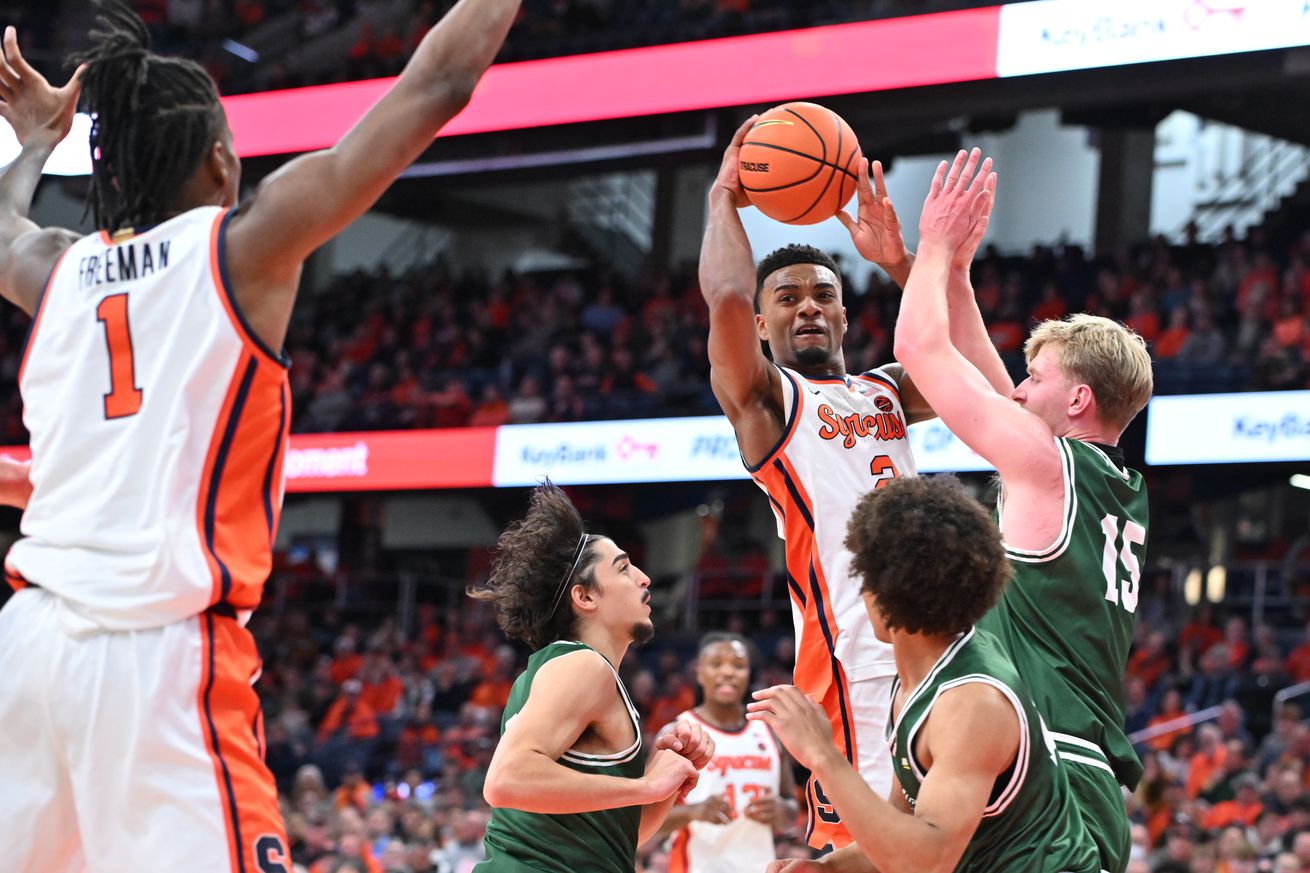
With Starling and Freeman both back in the fold, Syracuse is hoping the duo can transform into the foundation.
Right now a majority of what the Syracuse Orange men’s basketball roster will look like next season remains in flux.
One thing is clear: the ceiling for the 2025-26 Orange will likely be determined by how well the duo of J.J. Starling and Donnie Freeman perform.
The duo formerly announced their return to Syracuse on Tuesday, giving coach Adrian Autry the program’s top-two scorers and arguably two-best players from last year’s team. More importantly, they’re now going to be trusted as the foundation Autry and the program can build around next season, in addition to fully unlocking their potential in what has a chance to be a sneaky-good one-two punch.
Both players each had their highs and lows during the 2024-25 (and we’ll get to those, because there definitely were some of the latter), but Starling and Freeman overall had strong, promising campaigns fans should be encouraged by.
Beginning with Starling, the returning guard faced an uphill climb entering this past year. His former backcourt teammate, Judah Mintz, headed off to the NBA Draft process. Syracuse’s incoming transfers, both at the time and in hindsight, didn’t have the consistent scoring gravity to take the pressure off Starling. A midseason hand injury left Starling watching from the sidelines when the team desperately missed his production.
When the dust finally settled, Starling finished with career-highs in points (17.8), rebounds (3.8) and assists (2.8), playing over 34 minutes per game in 26 games. He also set career-highs in field goal attempts per game (16.0, nearly four more than 2023-24) and free throw attempts (4.9, over three more than 2023-24).
Starling ended the year as an honorable mention All-ACC selection, finished seventh in the conference in scoring and reached double-digits in points 23 times in 26 games, 10 of which saw him score at least 20.
The key takeaway: retaining a proven scorer will always have value for a competitive college basketball team. Not having to replace neither the shooting volume nor the total points scored is a big bonus for Autry.
The criticism around Starling is fair. The two most common concerns for Syracuse fans: inefficiency and defense.
The latter of those might remain a problem to navigate around, but that’s why this offseason is critical. For any offensive hub, it’s hard to be the only true go-to scorer and give 100% energy on defense. Of course, his defense needs to at least be durable enough to not give up an easy blow by or miss a coverage. On the flip side, there’s a case that the Orange will absolutely need to bring in more offensive help, so Starling doesn’t need to be *the* lone scoring option.
That could also help with the lack of efficiency, which did indeed manifest itself with career-lows in field goal percentage (40.7%) and three-point percentage (26.8%). Part of that inefficiency could also be coming back during the season from injury and having to ramp up almost immediately because the Orange desperately needed the scoring punch.
Moving over to Freeman, he was right behind Starling as Syracuse’s most indispensable player last year.
The Orange desperately missed Freeman’s versatility, specifically being able to match him up with quicker, more mobile scorers inside to cover for Eddie Lampkin’s limitations and having the flexibility to not over-rely on Jyare Davis to hold down the four spot.

Photo by Bryan Bennett/Getty Images
Like Starling, Freeman dealt with an injury of his own. A lower right leg injury eventually led to Freeman needing surgery, leaving him sidelined for all but three of Syracuse’s ACC games last year.
The sample size for the Orange’s promising recruit from 2024 remains small, sitting now at just 13 games, but the impact was pretty strong. The highlights: nine games in double-figures, six double-doubles and seven games with 10+ rebounds.
Freeman’s freshman year was cut short early on, but the rebounding proved to be a lot better than expected, the scoring efficiency (50.4% from the field) and diversity of shot-making was there and the versatility was, without a doubt, valuable in 2024-25 and will likewise be valuable in 2025-26.
Similar to Starling, Freeman’s main focus to work on is defense. He had the flashes and promise, but in this bigger role he’ll now be saddled with next year, it’s going to be a key aspect for how well the Orange’s future frontcourt ends up performing.
The same goes for the scoring potential. Freeman took 8.3 field goal attempts per game last year. The three-point sample size was small, but he was 20% from there on 2.5 attempts a game. What the general role and game-to-game usage looks like will be key to watch.
Heading into next year, both Starling and Freeman will have plenty of avenues to improve in hopes of anchoring the Orange going forward. Without question, their performance will dictate a substantial part in what the final result in 2025-26 ends up being for Syracuse.
All that being said, bringing both back in the same offseason can’t be overstated.
After all, a world with Starling and Freeman both back is certainly better than the world without either.